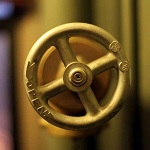Check valves from Alloy Valve Stockist
Looking for valves in exotic alloys? We stock check valves in 6MO 6moly), 254 SMO, 904L, AL-6XN, Alloy 20, Aluminum Bronze, Duplex, Hastelloy, Incoloy, Inconel, Monel, Nickel alloy, Austenitic stainless steel, Super Duplex, Titanium, Uranus B6 and Zirconium.
See also:
• Ball check valves
• Dual plate check valves
• Lift check valves
• Piston check valves
• Pressure seal check valves
• Wafer check valves
Check valves are used to allow fluid flow in a system in only one direction. They are operated by the flow of fluid in the piping. A check valve may be the swing type, lift type, or ball type. Most valves can be classified as being either stop valves or check valves. Some valves, however, function either as stop valves or as check valves-depending on the position of the valve stem. These valves are known as stop-check valves.
A stop-check valve looks very much like a lift-check valve. However, the valve stem is long enough so when it is screwed all the way down it holds the disk firmly against the seat, thus preventing any flow of fluid. In this position, the valve acts as a stop valve. When the stem is raised, the disk can be opened by pressure on the inlet side. In this position, the valve acts as a check valve, allowing the flow of fluid in only one direction. The maximum lift of the disk is controlled by the position of the valve stem. Therefore, the position of the valve stem limits the amount of fluid passing through the valve even when the valve is operating as a check valve. Stop-check valves are widely used throughout the engineering plant.
Stop-check valves are used in many drain lines and on the discharge side of many pumps.
A ball-check valve is a check valve in which the ball, sometimes called a lift, can be lifted up off its seat by higher pressure of inlet or upstream fluid to allow flow to the outlet or downstream side. A guide keeps motion of the disc on a vertical line, so the valve can later reseat properly. When the pressure is no longer higher, gravity or higher downstream pressure will cause the ball to lower onto its seat, shutting the valve to stop reverse flow.
Dual plate check valves are designed to overcome the size and pressure drop limitations of the swing and disc type wafer check valves. The flap of the swing check valve is essentially split and hinged down its centre, such that the two disc plates will only swing in one direction. The disc plates are held against the seat by a torsion spring mounted on the hinge. In order to hold the hinge in the centre of the flow path, externally mounted retainer pins can be used. These retainer pins are a common source of leakage from the valve. An improved design secures the hinge internally, and as the valve mechanism is entirely sealed within the body, leakage to atmosphere is prevented.
The valve is normally closed, as the disc plates are kept shut by the torsion spring. When fluid flows in the forwards direction, the pressure of the fluid causes the disc plates to hinge open, allowing flow. The check valve is closed by the spring as soon as flow ceases, before any reverse flow can occur. The frequent opening and closing of the split disc check valve would soon cause seat damage if the heels of the disc plates were allowed to scuff against the seat during opening. To overcome this, the heel of the disc plates lift during the initial opening of the valve and the plates rotate purely on the hinge as opposed to the seat face.
The split disc type of check valve has several advantages over other types of check valves:
• The split disc design is not limited in size and these valves have been produced in sizes of up to DN5400.
• The pressure drop across the split disc check valve is significantly lower than across other types.
• They are capable of being used with lower opening pressures.
• Split disc check vales can be installed in any position, including vertical pipelines.
A lift-check valve is a check valve in which the disc, sometimes called a lift, can be lifted up off its seat by higher pressure of inlet or upstream fluid to allow flow to the outlet or downstream side. A guide keeps motion of the disc on a vertical line, so the valve can later reseat properly. When the pressure is no longer higher, gravity or higher downstream pressure will cause the disc to lower onto its seat, shutting the valve to stop reverse flow.
A piston-check valve is a check valve in which the disc, sometimes called a piston, can be lifted up off its seat by higher pressure of inlet or upstream fluid to allow flow to the outlet or downstream side. A guide keeps motion of the disc on a vertical line, so the valve can later reseat properly. When the pressure is no longer higher, gravity or higher downstream pressure will cause the piston to lower onto its seat, shutting the valve to stop reverse flow.
Pressure seal construction is adopted for valves for high pressure service, typically in excess of above 170 bar. The unique feature about the pressure seal Bonnet is that the body-Bonnet joints seals improves as the internal pressure in the Valve increases, compared to other constructions where the increase in internal pressure tends to create leaks in the body-bonnet joint.
Relying on fairly simple design principles, pressure seal valves have proven their capability to handle increasingly demanding fossil and combined-cycle steam isolation applications, as designers continue to push boiler, HRSG, and piping system pressure/temperature envelopes. Pressure seal valves are typically available in size ranges from 2 inches to 24 inches and ASME B16.34 pressure classes from #600 to #2500, although some manufacturers can accommodate the need for larger diameters and higher ratings for special applications.
Pressure seal valves are available in alloy grades for over 500�C. The pressure seal design concept can be traced back to the mid-1900s, when, faced with ever increasing pressures and temperatures (primarily in power applications), valve manufacturers began designing alternatives to the traditional bolted-bonnet approach to sealing the body/bonnet joint. Along with providing a higher level of pressure boundary sealing integrity, many of the pressure seal valve designs weighed significantly less than their bolted bonnet valve counterparts.
Swing check and lift check, whether piston or ball type, tend to require a large amount of body material and can be both bulky, and depending on the body material, expensive. Wafer check valves, however, are slim and can be bolted directly to the receiving flanges through the bore holes on the outer rim of the wafer check valve. This design is lighter, and hence much cheaper when compared to swing and lift-check valves in the same diameter and pressure class.


